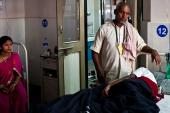Aspirin as Secondary Prevention Still Subpar, Especially in Lower-Income Countries
Despite some gains over the past decade, aspirin use hasn’t risen as much as hoped—pointing to the need for new strategies.

Aspirin continues to be underused as a means of secondary prevention, particularly in countries with low per capita incomes but also in wealthier nations, a new analysis shows.
The study combined data from health surveys taken across the world by more than 100,000 people between 2013 and 2020. Four in 10 of those with a history of cardiovascular disease—MI, stroke, or angina—reported taking aspirin.
Lead author Sang Gune K. Yoo, MD (Washington University School of Medicine, St. Louis, MO), said he and his colleagues were “disappointed” by what they found.
In the years spanning 2003 to 2009, just 25.3% of people who’d had a coronary heart disease event were taking an antiplatelet drug, predominantly aspirin, according to a prior study by the PURE investigators.
Now, a decade later, “I think we had hoped the rates of aspirin use would have increased [more] since then, after many years to promote cardiovascular health,” he told TCTMD. Progress has been made in other clinical scenarios, including the growing uptake of antiretrovirals in HIV, over the same time frame, Yoo pointed out, but CVD prevention has lagged.
I think we had hoped the rates of aspirin use would have increased [more] since then, after many years to promote cardiovascular health. Sang Gune K. Yoo
“Unfortunately, our current study cannot explain why aspirin is so underused, but I’m sure there are multiple explanations for this,” he noted. “For example, in the United States, aspirin is over the counter, but that’s not always the case in [other] countries,” where a consultation with a pharmacy or prescription could be required. Also, there may need to be better messaging at the patient-provider level about why aspirin is beneficial as secondary prevention, particularly given news in primary prevention, where aspirin is no longer advised. Or on a larger scale, he added, differences in health systems or political climates could be a deterrent to optimal care.
“It’s a multilevel challenge that requires multilevel strategies to improve aspirin use,” said Yoo.
These data are a reminder that even in high-income countries like the United States, where aspirin use as secondary prevention isn’t universal, clinicians should be attuned to whether their patients are receiving optimal medical therapy after a CVD event, he suggested. If not, it’s time to “investigate that further and be curious why patients are not on medicines when they should be. . . . It allows us to pause for a minute.”
Least Use Seen in Lowest-Income Countries
Yoo and colleagues performed a cross-sectional analysis that included 124,505 adults ages 40 to 69 years (median age 52 years; 50.5% women) who had participated in nationally representative health surveys between 2013 and 2020.
In all, 51 countries were represented. The researchers divided them based on per capita income, expressed in US dollars, during the years the surveys were conducted:
- Low income (< $1,000), such as Afghanistan and Ethiopia
- Lower middle income ($1,000-$4,000), such as Armenia and Bangladesh
- Upper middle income ($4,000-$12,000), such as Ecuador and Iran
- High income (> $12,000), such as Czechia, England, and the United States
Approximately 8% of the individuals reported having a history of CVD. Among them, 40.3% said they used aspirin for secondary prevention—with that figure ranging from 16.6% in low-income countries up to 65.0% in high-income countries. Use in countries with lower middle income or upper middle income fell in the center, at 24.5% and 51.1%, respectively.
Only 10 of the 51 countries met the World Health Organization’s target of at least 50% aspirin use by people with CVD: Belarus, Czechia, England, Iran, Iraq, Jordan, Kuwait, Lebanon, Turkmenistan, and the US.
Aspirin users tended be older, male, more educated, and living in urban areas. Even among individuals with these traits, however, the per capita income of their country still influenced the likelihood of taking aspirin. Additional analyses showed that 41% of the variation in aspirin use across countries could be explained by differences in per capita income.
Yoo said that, going forward, he hopes to see more implementation science: studies of “strategies that target different populations and communities that are contextualized to that particular place, in order for us to have a successful outcome in terms of improving uptake of evidence-based medications.”
Caitlin E. Cox is News Editor of TCTMD and Associate Director, Editorial Content at the Cardiovascular Research Foundation. She produces the…
Read Full BioSources
Yoo SGK, Chung GS, Bahendeka SK, et al. Aspirin for secondary prevention of cardiovascular disease in 51 low-, middle-, and high-income countries. JAMA. 2023;330(8):715-724.
Disclosures
- Yoo reports no relevant conflicts of interest.





Comments